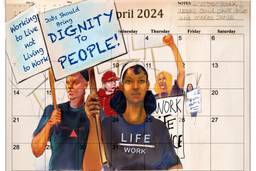Labor Takes a Seat in the Classroom
Educators are taking steps to bring union history into American schools
Adam Doster

A worker approaches the three-person National Labor Relations Board (NLRB) panel after filing a union grievance that her boss dismissed on unreasonable grounds. The board consults organized employees, workers with anti-union sensibilities and even the old boss to find out the details. Her complaint? The supervisor canned her because she had blonde hair and blue eyes. After some consultation, the board reaches a verdict. But, in this case, the ruling isn’t as important as the process itself.
Mock union battles like this once took place in Paul F. Cole’s classroom. Now the secretary-treasurer of the New York State AFL-CIO, Cole taught social studies at Lewiston-Porter Senior High School in Youngstown, N.Y. for 23 years. After becoming active in his local teacher’s union, he noticed labor history was absent from his lesson plans. So he went about infusing bits and pieces of organized labor into classes – running “organizing campaigns,” studying the lives of labor leaders and letting students debate issues like right-to-work legislation. “The goal is not to indoctrinate or proselytize kids. That’s unnecessary,” Cole says. “The goal is to provide kids with a deeper understanding of the history of the labor movement and the contributions workers have made to our economic, cultural and political history.”
Organized labor is rarely discussed in primary or secondary schools, and that is one reason the public is not adequately informed about the role unions have played in American life. A 2001 study by Hart Research found that 54 percent of respondents said they knew little to nothing about unions. Of those that had some knowledge, 37 percent gained it from personal experience, 26 percent from people in unions and 25 percent from the media. “They didn’t even ask the question whether they learned anything in school,” says Cole. “That’s an indictment right there.”
Labor’s omission from K-12 education contributes to a troubling paradox. While a 2004 Zogby poll found that 63 percent of Americans approve of unions, deeming them helpful to workers, employers and the economy at large, union membership continues to decline, falling to 12 percent of the 2006 working population. While labor education is no replacement for reformed labor laws, informing young people about the movement’s history and accomplishments may help the movement’s future.
The old left is left out
Howard Zinn, author of A People’s History of the United States, says traditional historians overlook the history of working people by focusing on those with excess political capital. “The general orientation of American history is towards the history of people at the top, towards the authority or the establishment,” Zinn says. As a result, curricula centers on political, military and business leaders, ignoring the rest.
Others contend that the study of racial and gender struggles in schools, while necessary and valuable, has shifted the focus away from an analysis of class. “My freshman students at college come out of California high schools with the language of race, ethnicity, and identity, and they have great facility with that,” says Nelson Lichtenstein, a labor historian at the University of California, Santa Barbara. “Issues of class and trade unions are often alien to them.” He cites César Chávez as a prime example of a progressive labor organizer whose history as a trade unionist is overshadowed by his legacy as an ethnic leader.
Teachers also affect how much exposure students have to labor’s stories. In an era marked by high-stakes testing, many teachers must narrow their curricula to exclude non-tested subjects. With little room for experimentation, it’s less likely that a stressed teacher, even if well versed in the narrative of labor struggles, would cover the 1914 Ludlow Massacre of striking Colorado coal miners at the expense of a topic assured to be on the next assessment.
Labor always has benefits
Teaching children about the contributions America’s working people have made to their lives provides important context. Restriction on child labor, the ever-longed-for weekend and public education itself were neither created in a vacuum nor implemented from the top; workers fought (and often got bloodied) in order to make life more palatable for Americans of all ages. Kids should know this when they are trying to make sense of the country’s political and economic landscape.
Because the United States is considered an individualistic society, history lessons often highlight personal crusades at the expense of collective rights as well. By teaching children that individual workers achieved both economic security and personal dignity when they realized their collective power, teachers can instill agency in young people and provide models that will help them solve contemporary problems. “Students can see union victories as a concrete example and they understand that there’s a historical prologue to what they are doing today,” says Rich Yeselson, a coordinator at the Change to Win federation’s Strategic Organizing Center. “They can see that change can happen if people explicitly come together to make [it].”
Instilling knowledge about labor’s past could also help revive the fortunes of the union movement. As union membership has dropped from 35 percent of the working population in 1950 to just above 10 percent today, it’s become harder for young people to learn first-hand the benefits of organizing. “Fifty years ago, you would hear [the value of unions] from people on the street, literally, from your friends and your neighbors,” says Yeselson. “With less union density, you hear less stories like that and you don’t know quite what a union does anymore.”
This severing of historical memory, through the loss of oral histories and personal connections, or diminished media coverage makes it harder for the labor movement to organize potential members. If young people have no knowledge of what unions can do, why spend the time and money to join? And without a strong labor movement, progressives can kiss a sustainable majority goodbye. “Going back to the French Revolution, the organization of work and workers stands at the core of democracy,” says Lichtenstein. “And unless that understanding is there, we’re going to be spinning our wheels.”
Sharing resources
The lack of attention paid to labor in U.S. schools is finally being addressed. Across the country, educators and nonprofit organizations are developing innovative ways to address unionism in the classroom. For example, the American Labor Studies Center (ALSC), based in upstate New York and headed by Cole, “collects, analyzes, evaluates, and disseminates labor studies curricula” to teachers nationwide through an interactive website. ALSC is also developing original educational programs. Partnering with the National Baseball Hall of Fame, the ALSC recently created “Hardballs and Handshakes,” an instructional unit that uses professional baseball as a case study to understand the power of bargaining. And while the social sciences may provide an obvious fit for the study of labor, Cole points out that English teachers can assign biographies of labor leaders, art and music teachers can study protest songs and posters, and science teachers can focus on workplace safety and health issues.
Other organizations are not far behind. The California Federation of Teachers (CFT) created Golden Lands, Working Hands, a 10-part video series that familiarizes students with California labor history. Lichtenstein even screens some of them in his college courses. Los Angeles teacher Linda Tubach, a CFT member, developed the Collective Bargaining Education Project 10 years ago, a student-run simulation that teaches high schoolers how labor and management resolve workplace conflicts through negotiations. What started as a one-day event in the City of Angels grew into a full-time project where organizers run workshops in school districts around the country.
Age-appropriate labor books are available as well. The United Association for Labor Education has organized a list of such resources on their website, including Zinn’s recently published two-volume series A Young People’s History of the United States, an adapted version of his bestseller. “I’ve had a good reaction from teachers who have written to me,” he says. “Middle school teachers have said how happy they were that a book like this exists.”
Key to the growth in K-12 labor studies has been the Internet, which has allowed teachers the opportunity to dig up scarce resources and share them with a broad audience. “With the click of the mouse, 43 million teachers are able to download our material for 50 million students,” says Cole. “Twenty years ago, there’s no way we could have afforded, as a non-for-profit organization, to collect and disseminate that much printed materials.”
The design of these labor lessons should not burden overworked educators. Most of the material is created to supplement the unit divisions that many textbook companies use, meaning that existing sections won’t need to be forfeited. Much of it is also standards-based, which is important for teachers worried about not conforming to No Child Left Behind. “We start with the standards and work backwards to find curriculum material that meets them,” says Cole. And for teachers wary about how to broach contentious topics, a few natural entry points already exist. Some states, like New York and California, have specifically implemented labor history weeks or months. And lacking that, there’s Labor Day, International Women’s Day or May Day. Further seeking out partnerships with teachers’ unions could add a valuable perspective, and be mutually beneficial.
The resources to teach students about America’s storied labor history are there. It’s up to educators to connect young people to a story that could have a lasting impact. “You want the people who read history, young people or people of any age, to recognize their own power and to recognize themselves in history,” says Zinn. “After all, most of the people who are going to be reading and studying history are not going to be business executives. They are going to be working for a living.”






